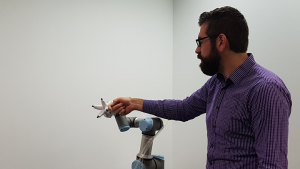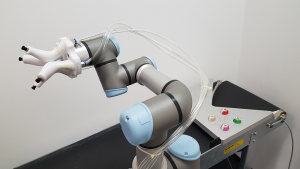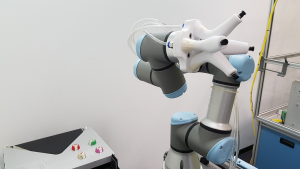3D printing solutions provider Creatz3D, which operates in Singapore and Vietnam, was founded in 2012 and works to bring awareness to the fact that 3D printing adoption needs to be accelerated in order for manufacturers to remain competitive in today’s landscape. The company works with educational and government facilities, in addition to commercial companies, to drive this acceleration, and recently completed a 3D printing case study with Universal Robots (UR) that led to major time and cost savings.
 The Danish company, which makes user-friendly industrial robots and has offices in the US, Latin America, Europe, and Asia, implemented the technology for its Multi-Axis Suction End-of-Arm Tooling (EOAT), which can be used in multiple industries to pick up multiple parts through independent vacuum channels.
The Danish company, which makes user-friendly industrial robots and has offices in the US, Latin America, Europe, and Asia, implemented the technology for its Multi-Axis Suction End-of-Arm Tooling (EOAT), which can be used in multiple industries to pick up multiple parts through independent vacuum channels.
As the current workforce starts to age out, and their expertise and experience go with them, it’s more important than ever to adopt new design paradigms in the manufacturing world, such as 3D printing and automation. While in the past robots may have been considered too dangerous to use on the factory floor, thanks to the advancements introduced by Industry 4.0, smaller collaborative robots, or cobots, can safely work next to humans in manufacturing settings. In fact, using 3D printing to make cobots means they can be more lightweight, which also makes them more efficient.
In warehouse settings, EOATs make sure that proper material “pick and place” flow is occurring, but standard, conventionally manufactured machines have some major limitations, such as hard to machine internal channels, reduced payload due to heavy tooling, and safety concerns due to sharp sheet metal edges.
The case study states, “CNC produced EOAT were restricted in design due to the constraints of traditional manufacturing and are unable to meet requirements. UR thus wanted to explore the opportunity of producing a lightweight EOAT that was able to pick multiple parts at a quicker pace. In addition, each end of the vacuum was to have their independent channels to accommodate different pick and place patterns.”
 UR was looking for an alternative means of producing EOATs that would help make them more lightweight and easier to program. A customized machine could pick up multiple uniquely shaped parts at a faster rate of speed, which would definitely help improve productivity. Creatz3D is a Stratasys reseller, and UR decided to use its Fortus 450mc FDM 3D printer to fabricate more durable, precise parts out of polycarbonate (PC) material, which was chosen for its excellent sealing and mechanical properties. PC offers more flexibility and strength than other thermoplastics, like ABS, and is also lightweight enough that robot arms can move quickly.
UR was looking for an alternative means of producing EOATs that would help make them more lightweight and easier to program. A customized machine could pick up multiple uniquely shaped parts at a faster rate of speed, which would definitely help improve productivity. Creatz3D is a Stratasys reseller, and UR decided to use its Fortus 450mc FDM 3D printer to fabricate more durable, precise parts out of polycarbonate (PC) material, which was chosen for its excellent sealing and mechanical properties. PC offers more flexibility and strength than other thermoplastics, like ABS, and is also lightweight enough that robot arms can move quickly.
By turning to 3D printing like UR did, manufacturers can make on-demand design iterations to parts, while requiring less lead time to complete low volume production runs. The technology offers more freedom in design when making customizable products, and parts can be made much more quickly and cost-efficiently as well.
In fact, by using 3D printing, UR was able to achieve time and cost savings, respectively, of 94.6% and 76%, and even lowered the number of components for assembly. The work was completed in less than five days, as opposed to taking weeks to finish. But that’s not all: UR also mounted a 3D printed modular bracket to the EOAT that could be used in the future to hold cameras and sensors to detect abnormalities during the machine’s pick and place operations.
However, after receiving some post-trial run feedback, the team realized that a change needed to be made to the bracket, and were able to quickly fix the problem.
“From the initial concept design which unfortunately posed a safety risk with the possibility that fingers could get stuck during operations, our engineers leveraged on the design freedom of 3D printing for a more effective solution with bent fingers,” the case study explains. “The use of FDM technology also allowed for the insertion of embedded inserts to the air supply connector and suction cup, which improved the overall durability of the EOAT tool and ability to pick up objects of varied sizes.”
Because UR had more design freedom thanks to its use of FDM 3D printing, the company was able to come up with a better solution than the original mounted design.
To see the revamped EAOT in action, watch the video from the case study on the Creatz3D website.
Discuss this news and other 3D printing topics at 3DPrintBoard.com or share your thoughts in the Facebook comments below.
[Images provided by Creatz3D]Subscribe to Our Email Newsletter
Stay up-to-date on all the latest news from the 3D printing industry and receive information and offers from third party vendors.
Print Services
Upload your 3D Models and get them printed quickly and efficiently.
You May Also Like
Making Space: Stratasys Global Director of Aerospace & Defense Conrad Smith Discusses the Space Supply Chain Council
Of all the many verticals that have been significant additive manufacturing (AM) adopters, few have been more deeply influenced by the incorporation of AM into their workflows than the space...
EOS in India: AM’s Rising Star
EOS is doubling down on India. With a growing base of aerospace startups, new government policies, and a massive engineering workforce, India is quickly becoming one of the most important...
PostProcess CEO on Why the “Dirty Little Secret” of 3D Printing Can’t Be Ignored Anymore
If you’ve ever peeked behind the scenes of a 3D printing lab, you might have caught a glimpse of the post-processing room; maybe it’s messy, maybe hidden behind a mysterious...
Stratasys & Automation Intelligence Open North American Tooling Center in Flint
Stratasys has opened the North American Stratasys Tooling Center (NASTC) in Flint, Michigan, together with automation integrator and software firm Automation Intelligence. Stratasys wants the new center to help reduce...






































